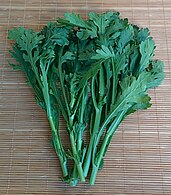Glebionis coronaria, formerly called Chrysanthemum coronarium, is a species of flowering plant in the family Asteraceae. It is native to the Mediterranean region.[3] It is cultivated and naturalized in East Asia and in scattered locations in North America.[4][5]
| Garland chrysanthemum | |
|---|---|
 | |
| Scientific classification | |
| Kingdom: | Plantae |
| Clade: | Tracheophytes |
| Clade: | Angiosperms |
| Clade: | Eudicots |
| Clade: | Asterids |
| Order: | Asterales |
| Family: | Asteraceae |
| Genus: | Glebionis |
| Species: | G. coronaria |
| Binomial name | |
| Glebionis coronaria (L.) Cass. ex Spach | |
| Synonyms[1][2] | |
|
List
| |
Glebionis coronaria is used as a leaf vegetable. English language common names include garland chrysanthemum,[6] chrysanthemum greens,[6] edible chrysanthemum, crowndaisy chrysanthemum,[7] chop suey greens,[6] crown daisy,[6] and Japanese greens.[6]
Glebionis coronaria has been hybridized with related Argyranthemum species to create cultivars of garden marguerites.[8]
Characteristics
A leafy herb, the garland chrysanthemum is an annual plant. It has yellow ray florets grouped in small flower heads and aromatic, bipinnately lobed leaves. Its seeds are ribbed and winged cypselae.[9] The vegetable grows very well in mild or slightly cold climates, but will go quickly into premature flowering in warm summer conditions. Seeds are sown in early spring and fall.[citation needed]
"The plant is rich in minerals and vitamins with potassium concentrations at 610 mg/100 g and carotene at 3.4 g/100 g in edible portions. In addition, the plant contains various antioxidants (in stem, leaf, and root tissues) that have potential long-term benefits for human health, although toxic (dioxin) properties have also been observed. Extracts from C. coronarium var. spatiosum have been shown to inhibit growth of Lactobacillus casei, a beneficial human intestinal bacterium."[10]
Culinary uses
| Nutritional value per 100 g (3.5 oz) | |||||||||||||||||||||||||||||||||||||||||||
|---|---|---|---|---|---|---|---|---|---|---|---|---|---|---|---|---|---|---|---|---|---|---|---|---|---|---|---|---|---|---|---|---|---|---|---|---|---|---|---|---|---|---|---|
| Energy | 99 kJ (24 kcal) | ||||||||||||||||||||||||||||||||||||||||||
3.02 g | |||||||||||||||||||||||||||||||||||||||||||
| Dietary fiber | 3 g | ||||||||||||||||||||||||||||||||||||||||||
0.56 g | |||||||||||||||||||||||||||||||||||||||||||
3.36 g | |||||||||||||||||||||||||||||||||||||||||||
| |||||||||||||||||||||||||||||||||||||||||||
| †Percentages estimated using US recommendations for adults,[11] except for potassium, which is estimated based on expert recommendation from the National Academies.[12] | |||||||||||||||||||||||||||||||||||||||||||
The plant's greens are used in many Asian cuisines. Normally only the greens are consumed but the stronger tasting stalk can also be used. They can be simmered, steamed, stir fried, deep fried, or added to soups. When overcooked they can become bitter.[13]
In Korean cuisine, the plant is called ssukgat (쑥갓) and is used as an ingredient in various soups and stews, as well as a side dish (namul).
In Chinese cuisine, it is called tong ho choy in Cantonese, and tóng hāo cài (茼蒿菜) in Mandarin. It is used as an ingredient for stir-fries, stews, casseroles, and hotpots.[14] In traditional food culture it is seen as "warming" and thus was primarily eaten when it was cold.[13]
In Japanese cuisine, it is called shungiku (春菊 "spring chrysanthemum"), and is used in nabemono, mixed into rice, or drizzled with soy sauce and sesame seeds as a side dish.[citation needed] It is also commonly added to sukiyaki.[13]
In Vietnamese cuisine, the greens are known as cải cúc or tần ô, and are used in soup (canh) or as a side dish accompanying various noodle soups. In a hotpot, it is added at the last moment to the pot to avoid overcooking.[citation needed]
In Crete, a variety of the species called mantilida (μαντηλίδα) has its tender shoots eaten raw or steamed by the locals (see Greek cuisine).[citation needed]
Gallery
- Crown daisy flower (Israel)
- Crown daisies in blossom (Israel)
- Habit
- All-yellow form
- As a vegetable
- Field of Crown daisies
- Crown daisies in blossom (Israel)
- Leaves of G. coronaria 'Oasis'
References
External links
Wikiwand in your browser!
Seamless Wikipedia browsing. On steroids.
Every time you click a link to Wikipedia, Wiktionary or Wikiquote in your browser's search results, it will show the modern Wikiwand interface.
Wikiwand extension is a five stars, simple, with minimum permission required to keep your browsing private, safe and transparent.












